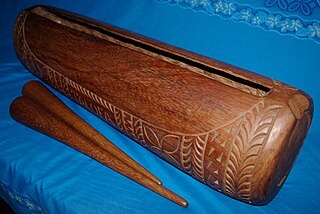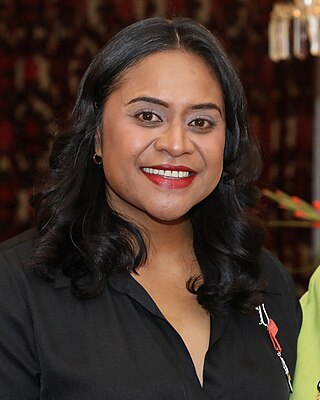Related Research Articles

Samoa, officially the Independent State of Samoa and until 1997 known as Western Samoa, is a Polynesian island country consisting of two main islands ; two smaller, inhabited islands ; and several smaller, uninhabited islands, including the Aleipata Islands. Samoa is located 64 km (40 mi) west of American Samoa, 889 km (552 mi) northeast of Tonga, 1,152 km (716 mi) northeast of Fiji, 483 km (300 mi) east of Wallis and Futuna, 1,151 km (715 mi) southeast of Tuvalu, 519 km (322 mi) south of Tokelau, 4,190 km (2,600 mi) southwest of Hawaii, and 610 km (380 mi) northwest of Niue. The capital and largest city is Apia. The Lapita people discovered and settled the Samoan Islands around 3,500 years ago. They developed a Samoan language and Samoan cultural identity.

Haka are a variety of ceremonial dances in Māori culture. A performance art, haka are often performed by a group, with vigorous movements and stamping of the feet with rhythmically shouted accompaniment. Haka have been traditionally performed by both men and women for a variety of social functions within Māori culture. They are performed to welcome distinguished guests, or to acknowledge great achievements, occasions, or funerals.
The Mau was a non-violent movement for Samoan independence from colonial rule during the first half of the 20th century. Mau means ‘resolute’ or ‘resolved’ in the sense of ‘opinion’, ‘unwavering’, ‘to be decided’, or ‘testimony’; also denoting ‘firm strength’ in Samoan. The motto for the Mau were the words Samoa mo Samoa. Similarly in Hawaiian Mau means to strive or persevere, and is often linked with Hawaiian poetry relating to independence and sovereignty struggles.

Savaiʻi is the largest and highest island both in Samoa and in the Samoan Islands chain. The island is also the sixth largest in Polynesia, behind the three main islands of New Zealand and the Hawaiian Islands of Hawaii and Maui. While it is larger than the second main island, Upolu, it is significantly less populated.

The Music of Samoa is a complex mix of cultures and traditions, with pre- and post-European contact histories. Since American colonization, popular traditions such as rap and hip hop have been integrated into Samoan music.

The traditional music of Tuvalu consists of dances, including fatele, fakanau and fakaseasea. The influence of the Samoan missionaries sent to Tuvalu by the London Missionary Society from the 1860s resulted in the suppression of songs about the traditional religions or magic and many songs were lost. As the influence of the missionaries diminished in the 20th century the traditional dances were revived and the siva dance tradition from Samoa also became popular.

The music of Tokelau occurs in the atolls of Atafu, Nukunonu, and Fakaofo. It is dominated by communal choral activity in harmony, with percussive accompaniment including log drums (pate), pokihi and apa. Nukunonu is notable for traditional song and dance.
New Zealand hip hop derives from the wider hip hop cultural movement originating amongst African Americans in the United States. Like the parent movement, New Zealand hip hop consists of four parts: rapping, DJing, graffiti art and breakdancing. The first element of hip hop to reach New Zealand was breakdancing, which gained notoriety after the release of the 1979 movie The Warriors. The first hip hop hit single, "Rapper's Delight" by the Sugarhill Gang, became a hit in New Zealand when it was released there in 1980, a year after it was released in the United States. By the middle of the 1980s, breakdancing and graffiti art were established in urban areas like Wellington and Christchurch. By the early 1990s, hip hop became a part of mainstream New Zealand culture.
The Polynesian Cultural Center (PCC) is a family-centered cultural tourist attraction and living museum located in Laie, on the northern shore of Oahu, Hawaii. The PCC is owned by the Church of Jesus Christ of Latter-day Saints, was dedicated on October 12, 1963, and occupies 42 acres of land belonging to nearby Brigham Young University–Hawaii (BYU-Hawaii).
The traditional culture of Samoa is a communal way of life based on Fa'a Samoa, the unique socio-political culture. In Samoan culture, most activities are done together. The traditional living quarters, or fale (houses), contain no walls and up to 20 people may sleep on the ground in the same fale. During the day, the fale is used for chatting and relaxing. One's family is viewed as an integral part of a person's life. The aiga or extended family lives and works together. Elders in the family are greatly respected and hold the highest status, and this may be seen at a traditional Sunday umu.

Samoans or Samoan people are the Indigenous Polynesian people of the Samoan Islands, an archipelago in Polynesia, who speak the Samoan language. The group's home islands are politically and geographically divided between the Independent State of Samoa and American Samoa, an unincorporated territory of the United States of America. Though divided by national border, the culture and language are the same.
Polynesian culture is the culture of the indigenous peoples of Polynesia who share common traits in language, customs and society. The development of Polynesian culture is typically divided into four different historical eras:
Papali'itele Max Amata Taogaga is a Samoan retired professional wrestler. He is best known for his appearances with the World Wrestling Federation (WWF) in the late-1980s under the ring name Siva Afi.

The fire knife is a traditional Samoan cultural implement that is used in ceremonial dances. It was originally composed of a machete wrapped in towels on both ends with a portion of the blade exposed in the middle. Tribal performers of fire knife dancing dance while twirling the knife and doing other acrobatic stunts. The towels are set afire during the dances, hence the name.
Sasa is a Samoan word for a particular group dance. The sasa can be performed by both males and females in a seated position or standing. Hand movements are used to depict activities taken from everyday life.

Samoan dance traditions reflect contact between Samoan culture and other cultures from the East and West. The space in which dance is conducted has been interpreted as a microcosm of Samoan society.
The Maulu'ulu is an indigenous dance performed by the Samoan people. Contemporary ma'ulu'ulu compositions and choreographies are generally performed by female dancers, although some villages have a tradition of men and women dancing together. The maulu'ulu was one of several dance forms and choral song styles that were brought into the Kingdom of Tonga through cultural diffusion in the late nineteenth century. Considerable divergence of technique and choreography now differentiate the Samoan maulu'ulu from the Tongan Ma'ulu'ulu, although their common origin continues to be celebrated.

Tupe Lualua is a New Zealand–Samoan choreographer, director, founder of the dance company Le Moana. She is the artistic director and producer for the Measina Festival, and has worked with choreographer Tupua Tigafua. In 2019, Lualua was the Creative New Zealand Samoa artist-in-residence.

Gaualofa is a reconstruction of a va'a-tele, a double-hulled Polynesian voyaging canoe. It was built in 2009 by the Okeanos Foundation for the Sea. It was given to the Samoa Voyaging Society in 2012, on the occasion of Samoa's 50th anniversary of independence. It is used to teach polynesian navigation.

The Pacifica Mamas Arts and Cultural Trust is an arts collective based in Auckland, New Zealand, with the mission to pass on traditional Pacific arts. The arts collective are based at the Pacifica Arts Centre, located in the Corban Estate Arts Centre.
References
- ↑ Jennifer Radakovich (2004). MOVEMENT CHARACTERISTICS OF THREE SAMOAN DANCE TYPES: MA'ULU'ULU, SASA AND TAUALUGA (MA). University of Hawai'i. p. 6-7. Retrieved 19 July 2022.
- 1 2 Lefaoali'i Dion Enari. "Siva Samoa in diaspora – Our connection home". The Coconet. Retrieved 19 July 2022.
- ↑ "Tautua Dance School bringing Siva Samoa to Whanganui". New Zealand Herald. 2 August 2021. Retrieved 19 July 2022.
- ↑ "What largest Samoan cultural dance school means to diaspora on Gold Coast". ABC. 19 June 2021. Retrieved 19 July 2022.